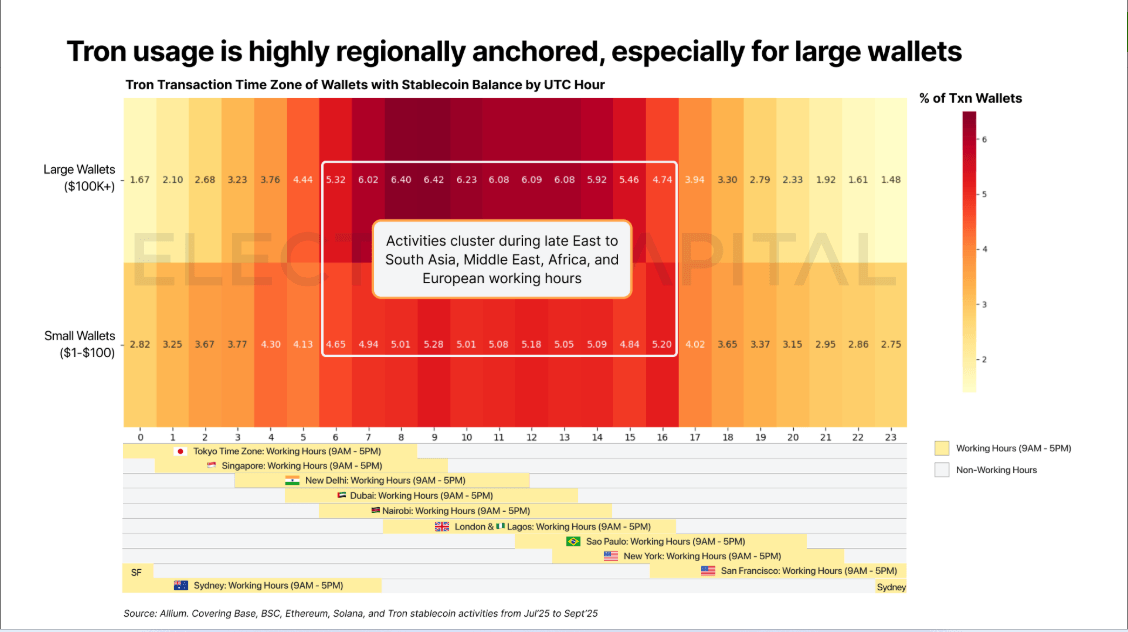A recent study by Electric Capital, a name that somehow sounds both futuristic and vintage, reveals that while stablecoin usage is global, the Americas lead in stablecoin activity compared to more populous regions. Ah, the irony of it all-spit in the face of population statistics, why don’t you? 🤷♂️
Wallet Size and User Activity Patterns
According to the latest study by Electric Capital, stablecoin usage is global, but the Americas generate more stablecoin activity than even more populous regions. The report highlights that large wallets-those holding $100,000 or more-tend to be active during business hours across Asia, the Middle East, Europe, and the U.S. East Coast. This pattern suggests institutional or professional users operating in major financial centers. Or, perhaps, just insomniacs with too much time and money on their hands. 🌃💸
In contrast, small wallets-holding $100 or less-exhibit a more globally distributed activity pattern, indicating that everyday users transact throughout the day across various regions. Ah, the proletariat of the crypto world, making their modest transactions while dreaming of Lamborghinis. 🚗✨

Regarding blockchain networks used, the study findings show balanced global usage for Ethereum and Solana, but with strong activity during working hours in both the Eastern (EST 2-6) and Western (EST 8-11) hemispheres. However, Tron, which handles a significant share of USDT transactions, and BSC are more concentrated in Asia, the Middle East, and Africa. A bit like a colonialist’s map, but with fewer ships and more digital tokens. 🗺️🌍
“BSC and Tron show remarkably similar patterns, with activity concentrated between UTC 6-15-aligning with working hours across Asia, the Middle East, and Europe. Both chains see less than 3% of activity during U.S. hours, indicating minimal relative Western adoption despite their large overall user bases,” the report notes. Ah, the East, always working while the West sleeps-some things never change. 🌅🏙️
Base, in contrast, demonstrates broader geographic diversity, with significant activity across multiple time zones. A true cosmopolitan in the world of chains. 🌐✨

When analyzing activity by chain, Ethereum maintains a globally distributed user base but shows strong usage in Western regions relative to their population share. Solana reveals a geographic split: large wallets concentrate in the Americas, while small wallets disperse globally. A tale of two solitudes, indeed. 🗽🌍
Base exhibits the most pronounced geographic divide, with small wallets skewing toward the East and large wallets toward the West. Meanwhile, BSC remains rooted in the Eastern Hemisphere with limited U.S. activity, and Tron shows even stronger regional concentration, especially among large wallets. Ah, the joys of geographic disparity-almost makes you nostalgic for simpler times. 🕰️🌎
FAQ 💡
- Where is stablecoin activity highest? The Americas lead in stablecoin usage despite smaller population size. Take that, demographics! 📊🥇
- When are large wallets most active? Large wallets transact during business hours in Asia, the Middle East, Europe, and the U.S. East Coast. Because apparently, even whales need a lunch break. 🐋🍽️
- Which chains show regional concentration? Tron and BSC are heavily used in Asia, the Middle East, and Africa, with minimal U.S. activity. A bit like tea preferences-very culturally specific. ☕🌍
- How does wallet size affect geographic usage? Small wallets are globally distributed, while large wallets show regional clustering by chain. The rich stay close to home; the rest of us wander. 🤷♂️🌐
Read More
- EUR HUF PREDICTION
- Is Bitcoin Playing Hard to Get? The Saucy Saga of Crypto’s Quiet Stage 🎩💼
- CNY JPY PREDICTION
- Launch Your Crypto Wallet Without the Headaches – Here’s How! 🤑
- USD ILS PREDICTION
- EUR MXN PREDICTION
- ETH vs BTC: The Tortoise 🏎️ Finally Outruns the Hare? 🐢
- CRV PREDICTION. CRV cryptocurrency
- USD VND PREDICTION
- EUR USD PREDICTION
2025-11-01 12:58